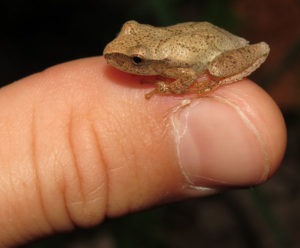
Spring peepers (Pseudacris crucifer) are small frogs that can be found throughout most of the eastern U.S. They are very common throughout most of their range. Spring peepers range in color from tan to grey and have an “X” on their back. These small frogs weigh less than 2 dimes and are only 0.75-1.5 inches long. On average, from the tip of your thumb to the first knuckle on your thumb is roughly an inch, so that gives you an idea of how small spring peepers are.
Spring peepers have pads on their toes that allow them to climb trees and other vegetation; however, they spend most of their time on or near the ground. Their coloration and small size make it hard to see them and they are more often heard than seen. Spring peepers are one of the first frogs to begin calling in the late winter and early spring. By April their calls can be almost deafening when you get close to a large congregation of them.
As the weather begins to warm up, spring peepers congregate around ponds, wet ditches, and vernal (temporary) pools near wooded areas. They prefer places that don’t have fish. Around sunset, the males will begin calling with their characteristic “peeps” that give them their name. The chorus of calling males attracts the larger females. Once a female chooses the male she wants to mate with, he will climb on top of her in an embrace called amplexus. The female will then give the male a piggyback ride as she swims around the pool of water laying eggs singly on submerged vegetation. The male externally fertilizes the eggs as they go. A single female may lay approximately 1,000 eggs although most will not survive to maturity.

Spring peeper eggs hatch within a few days. The tadpoles feed on algae and decaying plant matter. Any small fish, salamanders, leeches, or other predatory species living in the water where the eggs were laid will eat the tadpoles if they can catch them. It takes about 2-3 months for the tadpoles to mature into frogs. As adults, the spring peepers eat a variety of small insects and arthropods; however, they can still fall prey to larger animals that eat frogs.
Because they are so small and will breed in any wet area near wooded properties, spring peepers are common in suburban areas as well as more rural areas. In many parts of the eastern U.S., hearing the spring peepers begin calling is one of the first signs of spring. Hopefully you’ll have the opportunity to enjoy listening to them from the comfort of your own backyard as well.

This article was part of Shannon’s original Kentucky Pollinators and Backyard Wildlife blog which evolved into the blog for Backyard Ecology.

Backyard Ecology: Exploring Nature in Your Backyard
Nature isn’t just “out there.” It’s all around us, including right outside our doors. Hi, my name is Shannon Trimboli, and I am the host of Backyard Ecology. I live in southcentral Kentucky and am a wildlife biologist, educator, author, beekeeper, and owner of a nursery specializing in plants for pollinators and wildlife conservation. I invite you to join me as we ignite our curiosity and natural wonder, explore our yards and communities, and improve our local pollinator and wildlife habitat. Learn more or subscribe to my email list at www.backyardecology.net.

Leave a Reply